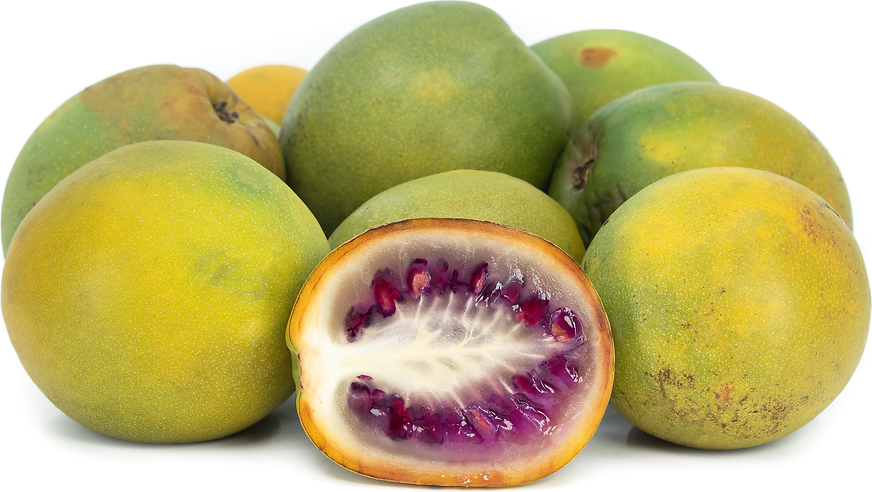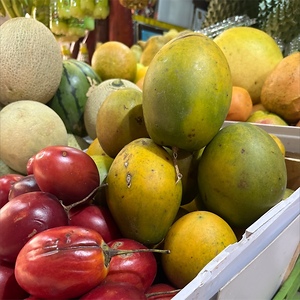


Chimbalo Fruit
Estimated Inventory, lb : 0
Description/Taste
Chimbalo fruits are small to medium in size, averaging 6 to 10 centimeters in length and 5 to 7 centimeters in diameter, and have an oval, round, to ellipsoidal shape with blunt, curved ends. The fruit’s skin is smooth, taut, and firm, ripening from green to variegated hues of yellow and orange. The skin may also exhibit brown markings due to weather and damage during cultivation, but these markings are generally superficial and do not affect the overall quality. Underneath the surface, a thin layer of white membranes encases a central cavity filled with gelatinous pulp and seeds. The soft pulp has purple hues and is aqueous, succulent, and slippery, and the tiny seeds are edible with a crunchy consistency. Chimablo fruits are edible raw and taste sweet, fruity, tangy, and subtly acidic.
Seasons/Availability
Chimbalo fruits are harvested in Colombia from October through November.
Current Facts
Chimbalo fruit, botanically classified as Cyphomandra sibundoyensis, is a wild South American species belonging to the Solanaceae or nightshade family. The fruits are native to Colombia and grow on small evergreen trees reaching 4 to 8 meters in height. Chimbalo is a fast-growing species, and the fruits are seasonally harvested as food and natural medicine. The fruits are also known as Tomate de Arbol Salvaje, Tomato Silvestre, Wild Tree Tomato, Forest Tamarillo, and Chimbalu, and are closely related to Tamarillos, Cyphomandra betacea, but typically larger in size. Chimbalo fruits are mostly wild, but the trees are cultivated on a small scale in their native regions. The fruits ripen slowly and are harvested by hand, but once picked, they have extended storage capabilities and can be kept longer than common commercial Tamarillos. Chimbalo fruits thrive in a specific microclimate in their indigenous region in Colombia and are challenging to cultivate outside the country. The fruits are primarily consumed fresh and are eaten raw or blended into juices.
Nutritional Value
Chimbalo fruits have not been studied for their nutritional properties. The wild fruits are primarily eaten in their native growing regions of Colombia and are said to be a source of vitamin C to strengthen the immune system. Chimbalo is also thought to contain antioxidants to protect the body's overall health and guard the cells against the damage caused by free radicals. A decoction of the leaves and the fruit pulp is utilized among the Kamsá or Kamëntsá indigenous people of the Sibundoy Valley in southwestern Colombia as a remedy to remove intestinal worms.
Applications
Chimbalo fruits have a sweet and sour flavor suited for fresh and cooked preparations. The species is primarily consumed fresh and is savored for its juicy, tangy, and flavorful flesh. The fruits can be sliced in half, and the flesh scooped with a spoon. Chimbalo fruits are also popularly incorporated into juices and contribute distinct fuchsia tones to drinks, giving them an appealing visual nature. In addition to juices, the fruits can be blended into milkshakes, pureed and frozen into ice cream and sorbets, or added fresh to salads. While less common, Chimbalo fruits are sometimes used in desserts or simmered into preserves, chutney, and various sauces. Chimbalo fruits pair well with other fruits such as pears, mango, and pineapple, honey, and nuts, including walnuts, pine, and almonds. Whole, unopened Chimbalo will keep for a few days when stored in a cool, dry, and dark place. It is recommended to consume ripe fruits immediately for the best quality and flavor. Chimbalo fruits can also be stored in the refrigerator for extended periods.
Ethnic/Cultural Info
Chimbalo fruit’s scientific name, Cyphomandra sibundoyensis, is derived from the species’ native growing region of the Sibundoy Valley in southwestern Colombia. The Sibundoy Valley is home to the indigenous communities of the Kamëntsá and Ingano, also known as the Inga people, and these communities are said to have existed in the region since ancient times. Beyond being harvested as a food source, Chimbalo fruits were once used in the Sibundoy Valley to produce yellow, black, or blue dyes. These dyes may have been used to color woven materials and fabric, including traditional ponchos called kapisaius and baitas.
Geography/History
Chimbalo fruit is native to Colombia and has been growing wild since ancient times. The species is found naturally growing in the cloud forests between 1400 to 2300 meters in elevation and is primarily localized to Sibundoy, a municipality in the Putumayo Department in southwestern Colombia. Much of the history of the Chimbalo fruit is undocumented, as the species has remained wild and mostly uncultivated. Some communities in Colombia may grow the plants in villages or home gardens for medicinal and culinary uses, but most Chimbalo fruits found in markets are foraged from wild trees. The species has also been planted in New Zealand, but the fruits struggled to grow in areas outside of their native habitat, eventually disappearing. Today, Chimbalo fruits are found in Colombia, mainly in the departments of Putumayo, Huila, and Narino, and are a rare species sold fresh in local markets.








